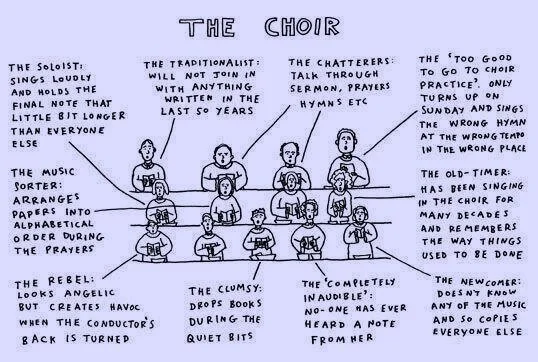By The Landlord
“I love to hear a choir. I love the humanity ... to see the faces of real people devoting themselves to a piece of music. I like the teamwork. It makes me feel optimistic about the human race when I see them cooperating like that.” – Paul McCartney
"In the church of my heart the choir is on fire." – Vladimir Mayakovsky
“So let me be thy choir, and make a moan
Upon the midnight hours.” – John Keats
"I belong to a gospel choir. They know I am an atheist but they are very tolerant." – Brian Eno
“The first time I sang in the church choir; two hundred people changed their religion.” – Fred Allen
They are the breeding ground of many great individual singers of all types, not merely classical but, via gospel, most often a church platform for moving on to soul and pop, from unison voice to universal acclaim, stars such as Aretha Franklin to Tina Turner, Whitney Houston to Barbra Streisand, Gladys Knight to Alicia Keys. Shakira wanted to sing in her local choir in Barranquilla, Columbia, but was rejected, and this spurred her on to succeed. Quincy Jones learned his many musical skills by singing in one as a boy, and it’s hard to think of musicians who haven’t at some stage had that early, formative experience. There are also some more who may not necessarily fit the angelic choirboy or choirgirl image – Axl Rose for example, and Keith Richards, who was spotted by Dartford Tech's choirmaster, R. W. "Jake" Clare, and became one of a pick of three boy sopranos who sang at at Westminster Abbey for the queen. Was it a valuable experience? Did he get from it what he might need?
So then, this week, our topic is, in any genre, music and songs featuring choirs, whether they are the main performers, or come alongside other musicians or singers and then play a prominent or pivotal role. We’ve previously done the topic of close harmony singing, but that mainly focused more on smaller groups of three or four. This time the music more about the sound of an assembled bigger group in harmony or unison.
Thinking about Keith in his cassock, it’s a cliche that choristers are angelic, and of course that is a myth. I was in a church choir from the age of 8 to 14. During long sermons I would continuously mess about with my best mate Michael, the two of us silently smirking in our cassocks and surplices, doing such mischief as pencil drawings of tits, cocks and bollocks in random places on hymn and prayer books, as well as other puerile but sometimes quite funny, clever obscenities, placing them around the church for a later date like little fireworks to go off and variously shock, amuse or put off pensioner parishioners, vicars and lay readers in mid-sentence, as well attract the attention of some blushing girl we might possible fancy.
Not all choirs are as musical as others
But choirs are brilliant at any age. Not only do they teach musical skills, but bring a sense of community. It was only some years later that I began to appreciate the education it gave me, not just from the choirmaster and organist Mr Holt, but also about human dynamics, about working together, about the extraordinary power of singing in unison or part harmonies, whether you're a soprano (also known as treble for boy choristers), alto, tenor or bass. I did all four eventually, and in that transition, mixing and chatting with people you wouldn't otherwise befriend, the music transcending all personality differences with the reverberation and exhilaration of being both one voice joined with many to make something altogether bigger than the sum of its parts.
Of course choirs are always in perfect harmony or unison. They contain a microcosm of society, and there is always something going on, some kind of struggle, sexual, or for control or other agendas going on under the score. Connie Willis, American sci-fi writer says: "It is my belief that everything you need to know about the world can be learned in a church choir.”
Choir parts
Choirs nourish talent of course, but in some cases, such as a young Tina Turner, it can cause friction. As a child she sang so loud in church she ruffled many a feather, trying to stand out, showing off, singing extra parts. Some choirs can stifle you.
Not always nourishing talent
But choirs can still welcome all types …
More Tony Soprano perhaps
Mavis Staples recalls how her voice didn’t quite fit the profile. “My high-school a cappella teacher would embarrass me in front of the choir. 'Mavis, you're in the basement. Mavis, you're singing with the boys.' I said, 'Mr. Finch, my voice isn't soprano. I can't sing up there with the girls.' So I just got out of the choir.”
Florence Welch is also singing out in the Bar today, singling out herself. “I'm a choir girl gone horribly, desperately wrong,” she reckons.
But let’s focus on some great examples, mostly outside the world of the more popular chart-topping genres. Tom Jones is here, unsurprisingly draws on his roots: “There is nothing like the sound of a Welsh Male Choir and the Treorchy is the finest. They have represented the best of the Welsh voice for generations with honour and integrity. They are international ambassadors.”
Here then is the Treorchy Male Voice Choir (Côr Meibion Treorci) singing Myfanwy:
Impressive in size, some in the US might turn to the likes of the Mormon Tabernacle Choir. They are a sensible, straight kind of ensemble, but surely a choir must have movement and energy, swinging the the sound, dancing a little even. So how about a little bit Mississippi Mass Choir?
Perhaps might care to go to another culture altogether, the likes the Russia’s Red Army, some and the stirring Song of the Volga Boatmen led by the great Leonid Kharitonov.
There are also some rather strange choirs around. Mieskuoro Huutajat (Men's Choir Shouters) is a Finnish choir that doesn't sing at all describing themselves "20-40 decently dressed men" who "scream, bellow and shout excerpts from national anthems, children's ditties or international treaties”. It’s a way of getting rid of your male angst, perhaps. Impressive beards too.
In terms of size, perhaps the biggest is The Number Nine Chorus from Osaka, a mega-choir made up of 10,000 mainly amateur singers who get together to perform Ode to Joy, the final movement of Beethoven's Ninth Symphony, every December. Massive.
And at the Old Low Light Heritage Centre in North Shields, the Mouths of the Tyne Community Choir were gathered to impersonate the song of the humpback whale, as organised into musical form by Icelandic composer Guðmundur Steinn Gunnarsson. They must have had a whale of a time doing that, but perhaps not quite as good as the real thing.
Bill Drummond, the man of The KLF, also formed what is called The 17, a project in which he has formed several choirs. Each work according to instructions called "scores" which contain no musical notation. There is no audience, no filmed footage and no recordings of their work. But they've performed all over the world.
There are scores of shouty pub choirs out there, football fan choirs and many local community groups just bringing people together to make some sounds as priority rather than being particularly musical, but I suspect this week we’re looking to focus of skill of delivery and beauty of sound. Tsintskaro is a Georgian folk song from the Kakhetian region familiar in a Kate Bush song, and also from the soundtrack of Werner Herzog’s 1979 film Nosferatu the Vampyre, and György Fehér's film Szürkület. Could a version, such as this by Vokal Ansambl Gordela, be in the mix this week?
Or you might want to go for some Bulgarian female voices, with their extraordinary harmonies.
But to finish, let’s see Aretha going back to her roots, and joining her father, as well James Cleveland and Southern California Community Choir at New Temple Missionary Baptist Church in Los Angeles in 1972 as captured in the documentary film finally released in 2018. The focus is on her of course, and that spine-tingling performance, but look how involved the choir are too, and spot how some of them are moved to weep with joy.
So then, I’m delighted to turn you over to this week’s crafty choirmaster, the marvellous magicman, who will be listening to all parts and help conduct everything in unison. Place your suggestions in comments below for deadline at 11pm UK time on Monday, for playlists published on Wednesday. Let’s sing out!
Join a choir? Why? Just because you can
New to comment? It is quick and easy. You just need to login to Disqus once. All is explained in About/FAQs ...
Fancy a turn behind the pumps at The Song Bar? Care to choose a playlist from songs nominated and write something about it? Then feel free to contact The Song Bar here, or try the usual email address. Also please follow us social media: Song Bar Twitter, Song Bar Facebook. Song Bar YouTube. Subscribe, follow and share.
Please make any donation to help keep Song Bar running:






